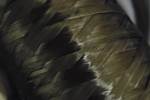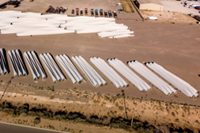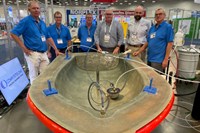Kraibon elastomer improves adhesion and composite material properties
Gummiwerk KRAIBURG’s elastomer product protects against impact, directly adheres to materials, improves damping properties and more.

Source | Gummiwerk KRAIBURG GmbH
Gummiwerk KRAIBURG GmbH (Waldkraiburg, Germany), a company of the Kraiburg Group featured on July 27 its Kraibon elastomers product. Comprised of a thin film made of non-vulcanized elastomers, the polymer chemically bonds to different materials with no additional production step needed, forming a hybrid material. Further, the technology is said to be compatible with the automotive, construction, sports, wind power, aeronautics, rail vehicles and medical industries.
According to Gummiwerk, by integrating elastomer into the composition of fiber-reinforced plastic (FRP), it is possible to achieve an alternating structure of hard and soft material that combines the good mechanical properties of the FRP with thache ideal “elastic” properties of the elastomer. Moreover, the company says Kraibon significantly improves the acoustic properties of FRP components, enabling structure-borne sound attenuation of up to 20 dB with only very little additional weight.
Direct integration of the elastomers into the manufacturing process for FRP components, and no need for additional bond agents also makes Kraiborn advantageous. In application, Kraibon is said to improve the properties of composite materials in the fields of damping, acoustics, splintering protection, lightweight construction and impact protection.
Gummiwerk notes that Kraiborn also enables a new level of quality in the hybrid combination of composite materials, ceramics, aluminum and metal.
Kraibon also enables a new level of quality in the hybrid combination of materials, such as composites (CFRP, FRP, NFRP, GFRP), ceramics, aluminum and metal, functioning as a “glue” between the different materials. The elastomers also are said to compensate for the differences in the material’s temperature ranges, resulting in excellent adhesion on both sides. Further, the product enables electrical insulating property between the different materials, preventing electrochemical corrosion.
Finally, Kraibon is said to protect against impact. For example, an integration of Kraibon elastomers into FRP enables the components to withstand up to
300% higher impact energies. This allows either higher damage tolerances and therefore a longer life or cost-effective production of a lighter component that delivers the same performance.
Related Content
-
Price, performance, protection: EV battery enclosures, Part 1
Composite technologies are growing in use as suppliers continue efforts to meet more demanding requirements for EV battery enclosures.
-
Cycling forward with bike frame materials and processes
Fine-tuning of conventional materials and processes characterizes today’s CFRP bicycle frame manufacturing, whether in the large factories of Asia or at reshored facilities in North America and Europe. Thermoplastic resins and automated processes are on the horizon, though likely years away from high-volume production levels.
-
The state of recycled carbon fiber
As the need for carbon fiber rises, can recycling fill the gap?















